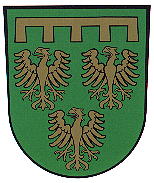Rommerskirchen: Difference between revisions
Jump to navigation
Jump to search
Knorrepoes (talk | contribs) m (Text replacement - "/Arms of " to "/Arms (crest) of ") |
Knorrepoes (talk | contribs) m (Text replacement - "{{media}}" to " {{de1}} {{media1}}") |
||
| Line 24: | Line 24: | ||
As none of the old municipalities used arms, new arms were devised. The arms are based on the arms of the Castle in Anstel, which used seals with the three eagles since 1355. The upper part was added and represents the five former municipalities. The colours represent agriculture (gold, wheat) and nature (green). | As none of the old municipalities used arms, new arms were devised. The arms are based on the arms of the Castle in Anstel, which used seals with the three eagles since 1355. The upper part was added and represents the five former municipalities. The colours represent agriculture (gold, wheat) and nature (green). | ||
{{ | |||
{{de1}} | |||
{{media1}} | |||
[[Civic Heraldry Literature - Germany|'''Literature''']]: Nagel, R. : Rheinisches Wappenbuch, Köln, 1986; | [[Civic Heraldry Literature - Germany|'''Literature''']]: Nagel, R. : Rheinisches Wappenbuch, Köln, 1986; | ||
Revision as of 11:43, 26 December 2022
This page is part of the German heraldry portal |
Heraldry of the World |
|
German heraldry:
|
Selected collector's items from Germany:
|
ROMMERSKIRCHEN
State : Nordrhein-Westfalen
District (Kreis) : Rhein-Kreis Neuss (until 1974 Grevenbroich)
Additions : 1975 Amt Rommerskirchen-Nettesheim, Amt Evinghoven, Frixheim-Anstel, Hoeningen, Nettesheim-Butzheim, Oekoven
| German | In Grün drei (2:1) goldene Adler unter einem fünflätzigen goldenen Turnierkragen. |
| English | No blazon/translation known. Please click here to send your (heraldic !) blazon or translation |
Origin/meaning
The arms were granted on October 4, 1979.
As none of the old municipalities used arms, new arms were devised. The arms are based on the arms of the Castle in Anstel, which used seals with the three eagles since 1355. The upper part was added and represents the five former municipalities. The colours represent agriculture (gold, wheat) and nature (green).
Literature: Nagel, R. : Rheinisches Wappenbuch, Köln, 1986;


